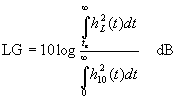
Lateral parameters

Calculation of lateral parameters requires microphone option omni-directional and figure-of-8, and both primary and secondary impulse response specified. It is further assumed that the omni-directional and the figure-of-8 microphones have the same sensitivities and are properly equalized with respect to each other, in the direction of maximum sensitivity. The two impulse responses should be measured in the same position, if possible simultaneously. The figure-of-8 should have one of the null-directions pointing either towards the source or along the long axis of the room, see ISO 3382. It is also extremely important that they are mutually synchronized, with matching absolute time scales. This can for instance be accomplished measuring with a feedback loop, providing responses with a true initial time delay.
The early lateral energy fraction is

(10)
where hL(t) is the impulse response measured with a figure-of-eight microphone with one of its nulls pointed towards the source. The time limits are td, the direct time, and te, the early time. LF is normally used for music application, with direct time 5ms and early time 80ms. The limit 5ms is introduced to make sure the direct sound is totally suppressed. The time limits can be changed in the boxes.
The late lateral strength is

(11)
This is a fairly new parameter, not mentioned in the standards so far, but it is believed to correlate well with subjective envelopment [J.S. Bradley and G.A. Soulodre, "Objective measures of listener envelopment," J. Acoust. Soc. Am., vol. 98, pp. 2590-2597 (1995)].
The upper integration limit in the numerator is taken as the truncation point determined in the decay curve formation for the lateral impulse response, or the end of the impulse response, according to the integration option specified. If compensation for truncated energy is calculated, this is taken into account as well to increase accuracy.
The reference energy in the denominator is calculated just as for strength, the same options govern the calculation, and similar comments on accuracy apply, see the Strength section.